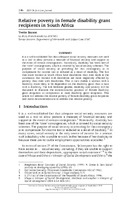| dc.contributor.author | Basson, Yvette | |
| dc.date.accessioned | 2022-01-12T10:56:13Z | |
| dc.date.available | 2022-01-12T10:56:13Z | |
| dc.date.issued | 2021 | |
| dc.identifier.citation | Basson, Y. (2021). Relative poverty in female disability grant recipients in South Africa. DE Jure,54, 346-358. 10.17159/2225-7160/2021/v54a20 | en_US |
| dc.identifier.issn | 2367-8410 | |
| dc.identifier.uri | 10.17159/2225-7160/2021/v54a20 | |
| dc.identifier.uri | http://hdl.handle.net/10566/7084 | |
| dc.description.abstract | It is a well-established fact that adequate social security measures are used
as a tool to allow persons a measure of financial security and support in
the event of certain contingencies. Historically, disability has been one of
the “core” contingencies, which is covered by social security schemes. The
purpose of social security in providing for this contingency is to
compensate for income lost or reduced as a result of disability. The fact
that more women in South Africa have disabilities than men leads to the
conclusion that women with disabilities are more negatively affected by
poverty than men with disabilities. This in turn makes a woman with a
disability more likely to be dependent on the disability grant than a man
with a disability. The link between gender, disability and poverty will be
discussed to illustrate the socio-economic position of female disability
grant recipients in comparison to male disability grant recipients. This
article will address the relative poverty of female disability grant recipients
and make recommendations to address this relative poverty. | en_US |
| dc.language.iso | en | en_US |
| dc.publisher | St Cyril and St Methodius University Publishing House | en_US |
| dc.subject | Poverty | en_US |
| dc.subject | Disability | en_US |
| dc.subject | Financial security | en_US |
| dc.subject | Female grant | en_US |
| dc.subject | South Africa | en_US |
| dc.title | Relative poverty in female disability grant recipients in South Africa | en_US |
| dc.type | Article | en_US |

